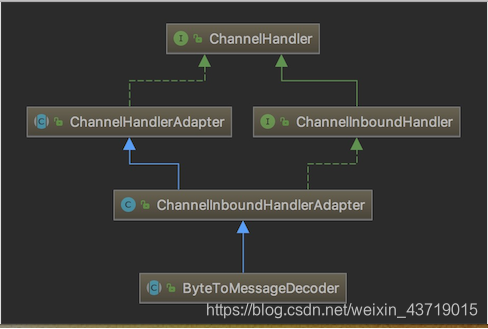8.1 基本说明
-
netty 的组件设计:Netty 的主要组件有 Channel、EventLoop、ChannelFuture、ChannelHandler、ChannelPipe 等
-
ChannelHandler 充当了处理入站和出站数据的应用程序逻辑的容器。例如,实现 ChannelInboundHandler 接口(或ChannelInboundHandlerAdapter),你就可以接收入站事件和数据,这些数据会被业务逻辑处理。当要给客户端发 送 响 应 时 , 也 可 以 从 ChannelInboundHandler 冲 刷 数 据 。 业 务 逻 辑 通 常 写 在 一 个 或 者 多 个ChannelInboundHandler 中。ChannelOutboundHandler 原理一样,只不过它是用来处理出站数据的
-
ChannelPipeline 提供了 ChannelHandler 链的容器。以客户端应用程序为例,如果事件的运动方向是从客户端到服务端的,那么我们称这些事件为出站的,即客户端发送给服务端的数据会通过 pipeline 中的一系列ChannelOutboundHandler,并被这些 Handler 处理,反之则称为入站的

8.2 编码解码器
-
当 Netty 发送或者接受一个消息的时候,就将会发生一次数据转换。入站消息会被解码:从字节转换为另一种格式(比如 java 对象);如果是出站消息,它会被编码成字节。
-
Netty 提供一系列实用的编解码器,他们都实现了 ChannelInboundHadnler 或者 ChannelOutboundHandler 接口。在这些类中,channelRead 方法已经被重写了。以入站为例,对于每个从入站 Channel 读取的消息,这个方法会被调用。随后,它将调用由解码器所提供的 decode()方法进行解码,并将已经解码的字节转发给 ChannelPipeline中的下一个 ChannelInboundHandler。
8.3 解码器-ByteToMessageDecoder
-
关系继承图

-
由于不可能知道远程节点是否会一次性发送一个完整的信息,tcp 有可能出现粘包拆包的问题,这个类会对入站数据进行缓冲,直到它准备好被处理.
-
一个关于 ByteToMessageDecoder 实例分析



8.4 Netty 的 handler 链的调用机制
实例要求:
- 使用自定义的编码器和解码器来说明 Netty 的 handler 调用机制
客户端发送 long -> 服务器
服务端发送 long -> 客户端




- 案例演示
Server端
public class MyServer {
public static void main(String[] args) throws Exception{
EventLoopGroup bossGroup = new NioEventLoopGroup(1);
EventLoopGroup workerGroup = new NioEventLoopGroup();
try {
ServerBootstrap serverBootstrap = new ServerBootstrap();
serverBootstrap
.group(bossGroup,workerGroup)
.channel(NioServerSocketChannel.class)
.childHandler(new MyServerInitializer()); //自定义一个初始化类
ChannelFuture channelFuture = serverBootstrap.bind(7000).sync();
channelFuture.channel().closeFuture().sync();
}finally {
bossGroup.shutdownGracefully();
workerGroup.shutdownGracefully();
}
}
}
public class MyServerInitializer extends ChannelInitializer<SocketChannel> {
@Override
protected void initChannel(SocketChannel ch) throws Exception {//出栈,入栈的Handler顺序是不会冲突的
ChannelPipeline pipeline = ch.pipeline();//一会下断点
//入站的handler进行解码 MyByteToLongDecoder
pipeline.addLast(new MyByteToLongDecoder());
//出站的handler进行编码
pipeline.addLast(new MyLongToByteEncoder());
//自定义的handler 处理业务逻辑
pipeline.addLast(new MyServerHandler());
System.out.println("xx");
}
/**
* 执行顺序:
* MyByteToLongDecoder ----> MyServerHandler
*/
}
public class MyByteToLongDecoder extends ByteToMessageDecoder {
/**
*
* decode 会根据接收的数据,被调用多次, 直到确定没有新的元素被添加到list
* , 或者是ByteBuf 没有更多的可读字节为止
* 如果list out 不为空,就会将list的内容传递给下一个 channelinboundhandler处理, 该处理器的方法也会被调用多次
*
* 如果Client发送16个字节的话,会被调用2次,同时下一个Handler也会执行2次,下面的结果
* xx
* MyByteToLongDecoder 被调用
* 从客户端/127.0.0.1:52740 读取到long 7017280452178371428
* MyByteToLongDecoder 被调用
* 从客户端/127.0.0.1:52740 读取到long 7017280452178371428
*
* @param ctx 上下文对象
* @param in 入站的 ByteBuf
* @param out List 集合,将解码后的数据传给下一个handler,InboundHandler
* @throws Exception
*/
@Override
protected void decode(ChannelHandlerContext ctx, ByteBuf in, List<Object> out) throws Exception {
System.out.println("MyByteToLongDecoder 被调用");
//因为 long 8个字节, 需要判断有8个字节,才能读取一个long
if(in.readableBytes() >= 8) {
out.add(in.readLong());
}
}
}
}
public class MyLongToByteEncoder extends MessageToByteEncoder<Long> {
//编码方法
@Override
protected void encode(ChannelHandlerContext ctx, Long msg, ByteBuf out) throws Exception {
System.out.println("MyLongToByteEncoder encode 被调用");
System.out.println("msg=" + msg);
out.writeLong(msg);
}
}
public class MyServerHandler extends SimpleChannelInboundHandler<Long> {//MyByteToLongDecoder传来的是Long
@Override
protected void channelRead0(ChannelHandlerContext ctx, Long msg) throws Exception {
System.out.println("从客户端" + ctx.channel().remoteAddress() + " 读取到long " + msg);
//给客户端发送一个long
ctx.writeAndFlush(98765L);
}
@Override
public void exceptionCaught(ChannelHandlerContext ctx, Throwable cause) throws Exception {
cause.printStackTrace();
ctx.close();
}
}
Client端
public class MyClient {
public static void main(String[] args) throws Exception{
EventLoopGroup group = new NioEventLoopGroup();
try {
Bootstrap bootstrap = new Bootstrap();
bootstrap.group(group).channel(NioSocketChannel.class)
.handler(new MyClientInitializer()); //自定义一个初始化类
ChannelFuture channelFuture = bootstrap.connect("localhost", 7000).sync();
channelFuture.channel().closeFuture().sync();
}finally {
group.shutdownGracefully();
}
}
}
public class MyClientInitializer extends ChannelInitializer<SocketChannel> {
@Override
protected void initChannel(SocketChannel ch) throws Exception {
ChannelPipeline pipeline = ch.pipeline();
//加入一个出站的handler 对数据进行一个编码 编码成自己流
pipeline.addLast(new MyLongToByteEncoder());
//这时一个入站的解码器(入站handler )
pipeline.addLast(new MyByteToLongDecoder());
//加入一个自定义的handler , 处理业务,肯定先将业务逻辑处理好的数据交给编码器处理
pipeline.addLast(new MyClientHandler());//这里是入栈的Handler
}
/**
* 执行顺序:
* MyClientHandler -----> MyLongToByteEncoder
* MyClientHandler 发送数据
* MyLongToByteEncoder encode 被调用
* msg=123456
*/
}
public class MyLongToByteEncoder extends MessageToByteEncoder<Long> {
//编码方法
@Override
protected void encode(ChannelHandlerContext ctx, Long msg, ByteBuf out) throws Exception {
System.out.println("MyLongToByteEncoder encode 被调用");
System.out.println("msg=" + msg);
out.writeLong(msg);
}
}
public class MyByteToLongDecoder extends ByteToMessageDecoder {
/**
*
* decode 会根据接收的数据,被调用多次, 直到确定没有新的元素被添加到list
* , 或者是ByteBuf 没有更多的可读字节为止
* 如果list out 不为空,就会将list的内容传递给下一个 channelinboundhandler处理, 该处理器的方法也会被调用多次
*
* 如果Client发送16个字节的话,会被调用2次,同时下一个Handler也会执行2次,下面的结果
* xx
* MyByteToLongDecoder 被调用
* 从客户端/127.0.0.1:52740 读取到long 7017280452178371428
* MyByteToLongDecoder 被调用
* 从客户端/127.0.0.1:52740 读取到long 7017280452178371428
*
* @param ctx 上下文对象
* @param in 入站的 ByteBuf
* @param out List 集合,将解码后的数据传给下一个handler,InboundHandler
* @throws Exception
*/
@Override
protected void decode(ChannelHandlerContext ctx, ByteBuf in, List<Object> out) throws Exception {
System.out.println("MyByteToLongDecoder 被调用");
//因为 long 8个字节, 需要判断有8个字节,才能读取一个long
if(in.readableBytes() >= 8) {
out.add(in.readLong());
}
}
}
public class MyClientHandler extends SimpleChannelInboundHandler<Long> {
@Override
protected void channelRead0(ChannelHandlerContext ctx, Long msg) throws Exception {
System.out.println("服务器的ip=" + ctx.channel().remoteAddress());
System.out.println("收到服务器消息=" + msg);
}
//重写channelActive 发送数据
@Override
public void channelActive(ChannelHandlerContext ctx) throws Exception {
System.out.println("MyClientHandler 发送数据");
//这里是Client端的 InboundHandler flush数据,从Client端的OutboundHandler发送出去到Socket到Server
ctx.writeAndFlush(123456L); //发送的是一个long
//如果发送下面的字符串“abcdabcdabcdabcd”,在Server会被调用2次,16个字节,一次读取8个字节,会读取2次,
// 但是这个时候 MyLongToByteEncoder 不会执行(原因下面有分析),Server会出现如下结果
/**
* xx
* MyByteToLongDecoder 被调用
* 从客户端/127.0.0.1:52740 读取到long 7017280452178371428
* MyByteToLongDecoder 被调用
* 从客户端/127.0.0.1:52740 读取到long 7017280452178371428
*
*/
//分析 MyLongToByteEncoder 不会执行的原因
//1. "abcdabcdabcdabcd" 是 16个字节
//2. 该处理器的前一个handler 是 MyLongToByteEncoder
//3. MyLongToByteEncoder 父类 MessageToByteEncoder
//4. 父类 MessageToByteEncoder
/*
public void write(ChannelHandlerContext ctx, Object msg, ChannelPromise promise) throws Exception {
ByteBuf buf = null;
try {
if (acceptOutboundMessage(msg)) { //判断当前msg 是不是应该处理的类型,如果是就处理,不是就跳过encode
@SuppressWarnings("unchecked")
I cast = (I) msg;
buf = allocateBuffer(ctx, cast, preferDirect);
try {
encode(ctx, cast, buf);
} finally {
ReferenceCountUtil.release(cast);
}
if (buf.isReadable()) {
ctx.write(buf, promise);
} else {
buf.release();
ctx.write(Unpooled.EMPTY_BUFFER, promise);
}
buf = null;
} else {
ctx.write(msg, promise);
}
}
4. 因此我们编写 Encoder 是要注意传入的数据类型和处理的数据类型一致
*/
// ctx.writeAndFlush(Unpooled.copiedBuffer("abcdabcdabcdabcd",CharsetUtil.UTF_8));
}
}

3) 结论
- 不论解码器 handler 还是编码器 handler 即接收的消息类型必须与待处理的消息类型一致,否则该 handler 不会被执行
- 在解码器 进行数据解码时,需要判断 缓存区(ByteBuf)的数据是否足够 ,否则接收到的结果会期望结果可能不一致
8.5 解码器-ReplayingDecoder
-
public abstract class ReplayingDecoder<S> extends ByteToMessageDecoder -
ReplayingDecoder扩展了ByteToMessageDecoder类,使用这个类, 我们不必调用 readableBytes() 方法。参数 S指定了用户状态管理的类型,其中 Void 代表不需要状态管理 -
应用实例:使用
ReplayingDecoder编写解码器,对前面的案例进行简化 [案例演示]
public class MyByteToLongDecoder2 extends ReplayingDecoder<Void> {
@Override
protected void decode(ChannelHandlerContext ctx, ByteBuf in, List<Object> out) throws Exception {
System.out.println("MyByteToLongDecoder2 被调用");
//在 ReplayingDecoder 不需要判断数据是否足够读取,内部会进行处理判断
out.add(in.readLong());
/** 不用判断了
if(in.readableBytes() >= 8) {
out.add(in.readLong());
}**/
}
}
- ReplayingDecoder 使用方便,但它也有一些局限性:
- 并 不 是 所 有 的 ByteBuf 操 作 都 被 支 持 , 如 果 调 用 了 一 个 不 被 支 持 的 方 法 , 将 会 抛 出 一 个
UnsupportedOperationException。 - ReplayingDecoder 在某些情况下可能稍慢于 ByteToMessageDecoder,例如网络缓慢并且消息格式复杂时,
消息会被拆成了多个碎片,速度变慢
8.6 其它编解码器
8.6.1 其它解码器
-
LineBasedFrameDecoder:这个类在 Netty 内部也有使用,它使用行尾控制字符(\n 或者\r\n)作为分隔符来解析数据。 -
DelimiterBasedFrameDecoder:使用自定义的特殊字符作为消息的分隔符。 -
HttpObjectDecoder:一个 HTTP 数据的解码器 -
LengthFieldBasedFrameDecoder:通过指定长度来标识整包消息,这样就可以自动的处理黏包和半包消息。
8.6.2 其它编码器

8.7 Log4j 整合到 Netty
- 在 Maven 中添加对 Log4j 的依赖 在 pom.xml
<dependency>
<groupId>log4j</groupId>
<artifactId>log4j</artifactId>
<version>1.2.17</version>
</dependency>
<dependency>
<groupId>org.slf4j</groupId>
<artifactId>slf4j-api</artifactId>
<version>1.7.25</version>
</dependency>
<dependency>
<groupId>org.slf4j</groupId>
<artifactId>slf4j-log4j12</artifactId>
<version>1.7.25</version>
<scope>test</scope>
</dependency>
<dependency>
<groupId>org.slf4j</groupId>
<artifactId>slf4j-simple</artifactId>
<version>1.7.25</version>
<scope>test</scope>
</dependency>

